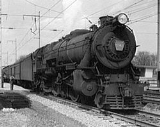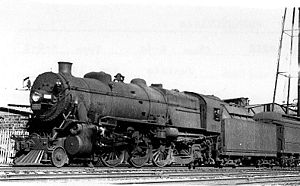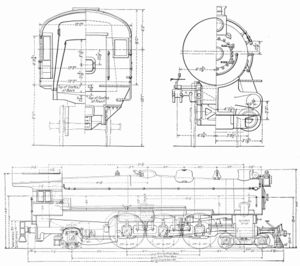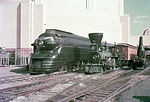
PRR K4s
Encyclopedia



Pennsylvania Railroad
The Pennsylvania Railroad was an American Class I railroad, founded in 1846. Commonly referred to as the "Pennsy", the PRR was headquartered in Philadelphia, Pennsylvania....
's K4s 4-6-2
4-6-2
4-6-2, in the Whyte notation for the classification of steam locomotives, represents the wheel arrangement of four leading wheels on two axles , six powered and coupled driving wheels on three axles, and two trailing wheels on one axle .These locomotives are also known as Pacifics...
"Pacific" (425 built 1914–1928, PRR Altoona, Baldwin
Baldwin Locomotive Works
The Baldwin Locomotive Works was an American builder of railroad locomotives. It was located in Philadelphia, Pennsylvania, originally, and later in nearby Eddystone, Pennsylvania. Although the company was very successful as a producer of steam locomotives, its transition to the production of...
) was their premier passenger-hauling steam locomotive
Steam locomotive
A steam locomotive is a railway locomotive that produces its power through a steam engine. These locomotives are fueled by burning some combustible material, usually coal, wood or oil, to produce steam in a boiler, which drives the steam engine...
from 1914 through the end of steam on the PRR in 1957.
Attempts were made to replace the K4s, including the K5
PRR K5
The Pennsylvania Railroad's class K5 was an experimental 4-6-2 "Pacific" type, built in 1929 to see if a larger Pacific than the standard K4s was worthwhile. Two prototypes were built, #5698 at the PRR's own Altoona Works, and #5699 by the Baldwin Locomotive Works. Although classified identically,...
and the T1
PRR T1
The Pennsylvania Railroad's 52 T1 class duplex-drive 4-4-4-4 steam locomotives, introduced in 1942 and 1946 , were their last-built steam locomotives and their most controversial. They were ambitious, technologically sophisticated, powerful, fast, and uniquely streamlined by Raymond Loewy...
duplex locomotive
Duplex locomotive
A duplex locomotive is a steam locomotive that divides the driving force on its wheels by using two pairs of cylinders rigidly mounted to a single locomotive frame; it is not an articulated locomotive...
, but none was really successful, and the K4s hauled the vast majority of express passenger trains until replaced by diesel locomotive
Diesel locomotive
A diesel locomotive is a type of railroad locomotive in which the prime mover is a diesel engine, a reciprocating engine operating on the Diesel cycle as invented by Dr. Rudolf Diesel...
s. The K4s was not powerful enough for the weight of trains it was often called upon to haul from the mid 1930s onward, and so they were often double or even triple headed. This was effective, but wasteful in that several crews were needed. The PRR did have the extra locomotives, because many had been displaced by electrification
Railway electrification system
A railway electrification system supplies electrical energy to railway locomotives and multiple units as well as trams so that they can operate without having an on-board prime mover. There are several different electrification systems in use throughout the world...
. Since the PRR had often referred to itself as the Standard Railroad of the World, the K4 has sometimes been referred to as the Standard Passenger Locomotive of the World.. The K4s is widely considered to be one of the greatest steam locomotives of all time.
It is recognized as the State Steam Locomotive of Pennsylvania.
Development
The K4s was designed under the supervision of PRR Chief of Motive Power J.T. Wallis, assisted by Chief Mechanical Engineer Alfred W. GibbsAlfred W. Gibbs
Alfred Wolcott Gibbs was a mechanical engineer in the railroad industry who attained the position of Chief Mechanical Engineer of the Pennsylvania Railroad....
and Mechanical Engineer Axel Vogt
Axel Vogt
Axel S. Vogt was the Pennsylvania Railroad's Chief Mechanical Engineer between March 1, 1887 and February 1, 1919. He was succeeded by William Frederic Kiesel, Jr. After retiring from the PRR, Vogt continued to consult for the Baldwin Locomotive Works until his death.- References :* Pennsylvania...
, as one of a pair of classes with the L1s
PRR L1s
Class L1s on the Pennsylvania Railroad comprised 574 2-8-2 "Mikado" type steam locomotives constructed between 1914 and 1919 by the railroad's own Juniata Shops as well as the Baldwin Locomotive Works and the Lima Locomotive Works ....
2-8-2
2-8-2
Under the Whyte notation for the classification of steam locomotives, 2-8-2 represents the wheel arrangement of two leading wheels on one axle , eight powered and coupled driving wheels on four axles, and two trailing wheels on one axle...
"Mikado", sharing a boiler and other features. A fair amount of inspiration came from the large experimental K29s Pacific built in 1911 by the American Locomotive Company
American Locomotive Company
The American Locomotive Company, often shortened to ALCO or Alco , was a builder of railroad locomotives in the United States.-Early history:...
. Also influential was Gibbs' design for the successful E6
PRR E6
Class E6 on the Pennsylvania Railroad was the final type of 4-4-2 "Atlantic" locomotive built by the railroad, and second only to the Milwaukee Road's streamlined class A in size, speed and power. Although quickly ceding the crack trains to the larger K4s Pacifics, the E6 remained a popular...
4-4-2
4-4-2 (locomotive)
Under the Whyte notation for the classification of steam locomotives, 4-4-2 represents the wheel arrangement of four leading wheels on two axles , four powered and coupled driving wheels on two axles, and two trailing wheels on one axle...
"Atlantics", from which the K4s inherited its heat-treated, lightweight machinery, its cast-steel KW trailing truck, and much in the way of general appearance.
The K4s design increased grate area from previous classes' 55 to 70 sq ft (5.1 to 6.5 m2). The boiler barrel was much fatter than previous classes, and the increase in heating surface and boiler size gave the class prodigious steam-generating capability. Equipment on the first prototype, built in 1914, was conservative and included a screw reverse (power reverse would soon be added), a small 70-P-70 tender holding only 7000 gallons (26,497.9 l) of water and 12½ tons of coal set up for hand firing, a wooden cowcatcher pilot
Pilot (locomotive)
In railroading, the pilot is the device mounted at the front of a locomotive to deflect obstacles from the track that might otherwise derail the train. In some countries it is also called cowcatcher or cattle catcher....
, a square-cased, old-fashioned headlight and piston tailrods (soon to go).
The K4s design was successful enough that it influenced other locomotive designs, and not only those of other PRR locomotives. London and North Eastern Railway
London and North Eastern Railway
The London and North Eastern Railway was the second-largest of the "Big Four" railway companies created by the Railways Act 1921 in Britain...
Chief Mechanical Engineer Nigel Gresley
Nigel Gresley
Sir Herbert Nigel Gresley was one of Britain's most famous steam locomotive engineers, who rose to become Chief Mechanical Engineer of the London and North Eastern Railway . He was the designer of some of the most famous steam locomotives in Britain, including the LNER Class A1 and LNER Class A4...
incorporated much of the boiler design (including the tapered shape) into his famous Class A1
LNER Class A1/A3
The London and North Eastern Railway LNER Gresley Classes A1 and A3 locomotives represented two distinct stages in the history of the British 4-6-2 "Pacific" steam locomotives designed by Nigel Gresley...
Pacific.
Production
Three years elapsed until production examples were constructed. Partly, this was due to extensive, exhaustive testing, but wartime necessitated priority in construction to the L1s Mikado type for freight. In 1917, Altoona's Juniata Shops started producing K4s in numbers. The first 168 carried widely scattered road numbers as traditional for the PRR, but subsequent locomotives produced after 1920 were assigned numbers in consecutive blocks.| Year | Quantity | Road numbers |
|---|---|---|
| 1914 | 1 | 1737 PRR 1737 The Pennsylvania Railroad's K4s class Pacific number 1737 was the prototype of the class of 4-6-2 steam locomotives that eventually would number 425 locomotives.... |
| 1917 | 41 | assorted numbers |
| 1918 | 111 | 3667–3684, 5334–5349, plus assorted numbers |
| 1919 | 15 | assorted numbers for PRR Lines West |
| 1920 | 50 | 3726–3775 |
| 1923 | 57 | 3800, 3801, 3805–3807, 3838–3889 |
| 1924 | 50 | 5350–5399 |
| 1927 | 92 | 5400–5491 |
| 1928 | 8 | 5492–5499 |
Numbers 5400–5474 were built by Baldwin, while all others were constructed at the PRR's Juniata Shops.
Modifications
The PRR experimented extensively with its K4s fleet, trying out streamlining, poppet valves, smoke deflectors, driving wheel types and others.Streamlining
A number of K4s locomotives had streamlining applied over the years, to varying degrees. All were later removed, restoring the locomotives to their original appearance.3768

Raymond Loewy
Raymond Loewy was an industrial designer, and the first to be featured on the cover of Time Magazine, on October 31, 1949. Born in France, he spent most of his professional career in the United States...
in February 1936 This was a very concealing, enveloping streamlined casing which hid most of the functionality of the steam locomotive, leading to its nickname of "The Torpedo" by train crews. At first, the locomotive was not painted in standard PRR green (DGLE) but instead in a bronze color. It was later refinished in DGLE. A matching tender was also produced, running on unusual six-wheel trucks. Like most streamlined steam locomotives, the shrouds impeded maintenance and the covers over the wheels were later removed. For a time, the locomotive was the preferred motive power for the Broadway Limited
Broadway Limited
The Broadway Limited was the Pennsylvania Railroad's premier named passenger train, operating daily in each direction between New York City and Chicago, via North Philadelphia. It replaced its predecessors, the Pennsylvania Limited and the Pennsylvania Special...
.
1120, 2665, 3678, and 5338

Henry Dreyfuss
Henry Dreyfuss was an American industrial designer.-Career:Dreyfuss was a native of Brooklyn, New York. As one of the celebrity industrial designers of the 1930s and 1940s, Dreyfuss dramatically improved the look, feel, and usability of dozens of consumer products...
's casings for NYC Hudson
NYC Hudson
Hudson was the name given to the 4-6-4 steam locomotive wheel arrangement by the New York Central Railroad which was the first to use locomotives of this type in North America.-History:...
s.

1188
K4s #1188 was given a boiler-top streamlined "skyline" casing, but no other streamlining, and was nicknamed "The Skyline".Boosters
K4s numbers 3676, 5399, and 5436 were fitted with booster engineBooster engine
A booster engine for steam locomotives is a small two-cylinder steam engine back-gear-connected to the trailing truck axle on the locomotive or, if none, the lead truck on the tender. A rocking idler gear permits it to be put into operation by the engineer...
s on the trailing trucks in 1941.
Poppet Valves
K4s 5399 was rebuilt by Lima in 1939, with, among other improvements, poppet valves actuated by Franklin oscillating cams. K4s 5436 was fitted with stem actuated valves in 1940. They were designed by Lloyd Jones, the Engineer of tests at the Altoona Works. in 1945, K4s 3847 was given a front-end throttle and Franklin rotary-actuated poppet valves. All performed well, but were difficult to maintain.K4sa
K4s numbers 612, 1985, 5405, 5481 and 5484 were converted with 15" piston valves, higher steam domes and circulators, and front-end throttles.Preservation
There are only two surviving K4s class locomotives. Number 3750PRR 3750
PRR 3750 is one of the two preserved class K4s Pacifics steam locomotive of the Pennsylvania Railroad.- History :Just like PRR 1361 the 3750 was used to haul the PRR's main line intercity passenger trains such as The Broadway Limited. Despite the attempt by PRR management to replace the K4s with...
is on display at the Railroad Museum of Pennsylvania
Railroad Museum of Pennsylvania
The Railroad Museum of Pennsylvania is a railroad museum in Strasburg, Lancaster County, Pennsylvania.The museum is located on the east side of Strasburg along Pennsylvania Route 741...
in Strasburg. Number 1361
PRR 1361
PRR 1361 is a preserved 4-6-2 locomotive operated by the Pennsylvania Railroad until 1957. This engine and 3750 are the only two preserved PRR K4s Pacifics. In 1957 the K4 was placed at Horseshoe Curve near Altoona. The Pacific remained there until 1986 in which she was removed and rebuilt to haul...
was set to be restored to operation by the Railroaders Memorial Museum
Railroaders Memorial Museum
The Railroaders Memorial Museum is a railroad museum in Altoona, Pennsylvania. The museum is dedicated to revealing, interpreting, commemorating and celebrating the significant contributions of railroaders and their families to American life and industry.Altoona is one of the hubs of the area's...
in Altoona through the restoration shop at Steamtown National Historic Site
Steamtown National Historic Site
Steamtown National Historic Site is a railroad museum and heritage railroad located on in downtown Scranton, Pennsylvania, at the site of the former Scranton yards of the Delaware, Lackawanna and Western Railroad . The museum is built around a working replica turntable and a roundhouse that is...
. However, due to the difficulty of overseeing the work, Altoona has halted the restoration until their restoration shop is completed. As of 2008, 1361 is sitting in pieces in a corner of Steamtown's roundhouse. In 2010, the Railroaders Memorial Museum announced that the restoration was to be canceled, and the engine, when it arrives at the museum, would be reassembled and receive only a cosmetic restoration. At that time, most of the restoration was completed save for that of the boiler and other components, so it is possible that the museum may resume the restoration to operating condition in the future.
Despite the publication in the paper, museum personnel have stated though the cosmetic restoration idea was discussed, it is still museum intention to restore the engine to operating status. With the announcement of NS restarting its own steam program, there also exists, at least a little hope, of a future with a K4 under steam on the high iron.
See also
- Railway engines (Thomas and Friends)Railway engines (Thomas and Friends)This article lists the standard gauge Railway Engine characters of the Television Series Thomas and Friends . These are the characters that run on the Fat Controller's railway....
, the list of engines from the popular television series Thomas and Friends includes Hank, an engine based on the K4s.
External links
- The Pennsylvania Railroad Pacifics at SteamLocomotive.com.
- PRR Steam Roster Pt6 - Class K.
- K4s - All of them! by Gary Mittner.

